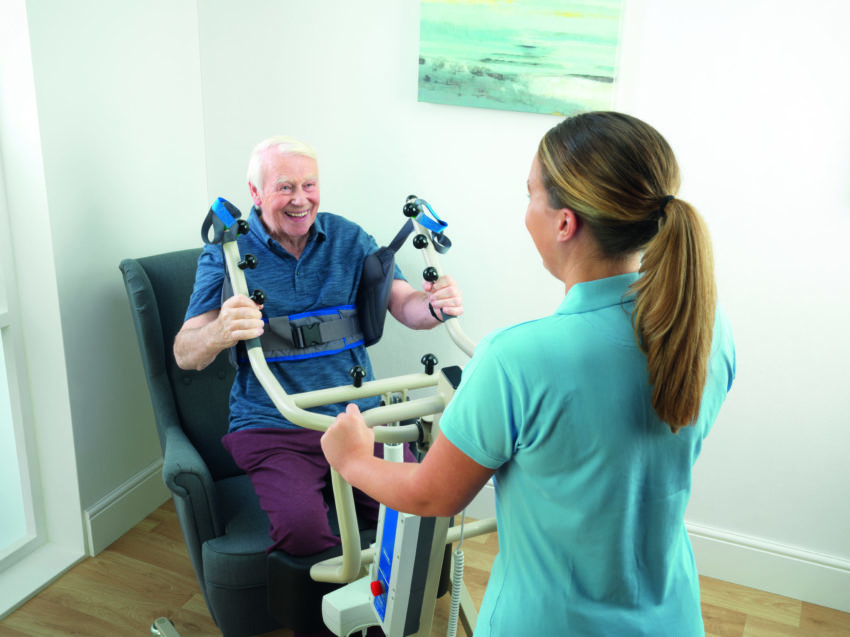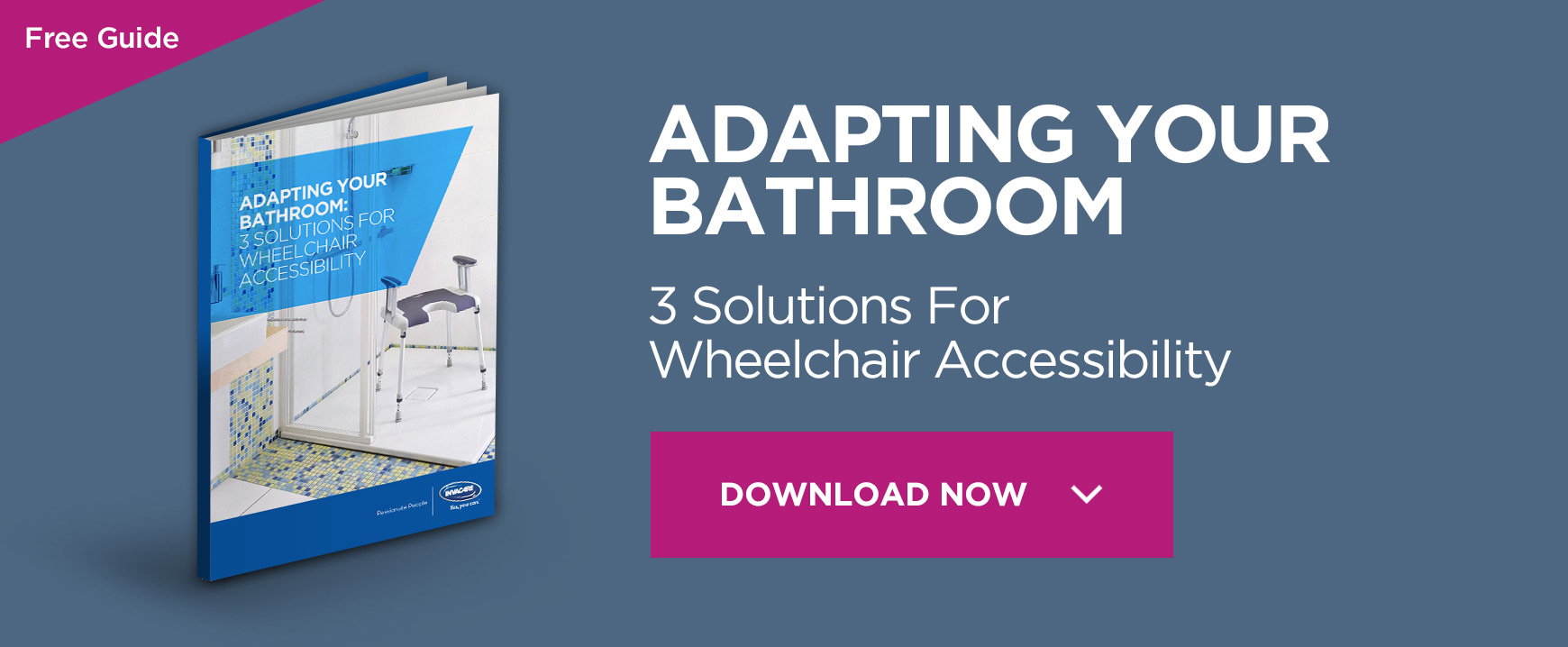Need a Stand Aid, What Are the Options?

Stand aids have transformed the way that care professionals are able to help people with limited mobility by allowing them to lift users with minimal strain. Stand aid hoists have become the preferred way for many care professionals to help their users with limited mobility move to various positions safely and with dignity.
What is a stand aid?
A stand aid is a patient lifting device that is designed to support people who struggle to stand unassisted. Stand aids, or sit-to-stand hoists, are used by people with disabilities and people with limited mobility, such as the elderly, to help them to get to their feet safely and comfortably. To use a stand hoist safely, the user must be able to support their body weight with their legs while using the hoist.
Types of stand aid
Stand aids come in two main different forms: mechanised and non-mechanised. There are also standing hoists with seats and standing hoists with belts.
Non-mechanised stand aids
Non-mechanised stand aids provide no mechanical assistance with the transfer but offer more leverage and remove the need for the user to twist or turn to move into the new position. These stand aids require the user to be able to pull themselves up into a standing position. Some of these standing hoists have a belt or straps to keep the person’s hips in extension, which makes standing easier. Other standing hoist models have a seat made of paddles that drop down behind the user, allowing them to sit while being transferred.
Mechanised stand aids
Mechanised stand aids are also known as an electric standing hoist and are especially useful for people who can support their weight for a short period but are unable to pull themselves up into a standing position. Slings can be used with patient lifting equipment, to enable a person to maintain a standing position whilst the transfer or functional task is completed.
Why use a mechanised stand aid?
A mechanised stand aid allows caregivers to safely help someone to their feet, and gives the user added support and confidence. There are a range of reasons why you or someone you care for might benefit from a stand aid, including:
Rehabilitation
Stand aids, or stand-up hoists, are an extremely useful resource for care professionals in treating people who have become deconditioned after a prolonged illness. People who may have been weight bearing and able to transfer themselves independently before an illness may find themselves struggling to stand unaided afterwards. A mechanised stand aids enables the professional to safely assess the person’s ability and grade the desired activity to match the user’s needs. The user is supported while they begin standing again after an illness or injury, helping to build their confidence.
Maintaining standing ability
Stand aids can also be used to maintain a person’s ability to stand. They can benefit people who are struggling to stand with the assistance of two people or are unable to pull themselves up using a non-mechanised stand aid.
In these circumstances, a stand aid can be an ideal solution that can be used in nursing and residential care settings, as well as in domestic home environments alongside a risk assessment and handling plan. The Invacare ISA Compact stand assist hoist offers a lightweight option with a short footprint that makes it ideal for smaller spaces in a home environment. Easy operating functions, battery charging and easy to clean surfaces also make it an effective and practical option for residential care environments.
Things to consider when choosing a stand aid?
Knowing how to choose the right stand aid can be tricky, but there are a few key things you should consider to help you make your decision:
Weight limit
It is important to select the right device for the intended user or users, to ensure they are safe and comfortable. The Invacare ISA XPLUS variant has a weight limit of 200 kilograms (approximately 31.5 stone). This gives health care providers more flexibility to support a wider range of patients with a stand aid.
Smooth and quiet movement
Many stand aids are noisy, and they can make uncomfortably sudden, jerky movements. This can make a person with a disability or an elderly patient already lacking confidence quite reluctant to use the stand aid, negatively affecting their rehabilitation. The Invacare ISA mechanism is designed in a way that keeps noise to a minimum and ensures its start and stop movements are exceptionally smooth. Look for features that will enhance user comfort, such as dampers that reduce rocking movements, and sling hooks with a larger surface area for more stability.
Ease of transport
If you will need to move the stand aid from place to place, then you will want to choose a model that can be folded or dismantled easily. Check if dismantling and assembling the stand aid will require tools and decide if this is something you are comfortable with. Standing aids that can be assembled without tools will make transportation simple and hassle free.
Risk assessment of the person
The first step for care professionals and family members looking to use a stand aid with a patient or loved one, is to carry out an assessment to ensure that the hoist is suitable. The user must be able to bear their own weight while standing, so this should be a key factor in any assessment. Also consider the person’s weight and whether they are within the equipment’s safe working limit.
Trialling the products with your patient or loved one first is a good idea, as it can help you both see if it is suitable for them. If you are in a nursing or residential care setting, we recommend getting an Occupational Therapy or Physiotherapy assessment.
Risk assessment of the environment
Assessing the environment that you plan on using the stand aid in is an important step in selecting the right standing aid. One easily overlooked, but crucially important, question when choosing a stand aid is where do you intend to use it? This is important because stand aids vary in length, weight, and chair clearance, which impact on functional gains. You should also consider your floor surface and space for turning circles to help keep everyone safe while using the standing aid. Finally, remember to check if there is room for the carer to provide support when using the stand aid.
Ergonomic design
Stand aids with ergonomic design makes using the hoist comfortable and easy for both the carer and user. This includes features such as legs that are curved that make it easy to move around chairs and bathroom furniture, and sling hooks that can be attached to the stand aid frame with one hand.
Carer training
The competence of handlers is extremely important, but some carers may not be familiar with a stand aid and may need extra training.
Want more information to help you decide?
Patient stand aids are vital tools that support people with movement disorders or weakness in their legs and those immobilized and recovering after surgery. They’re ideal for use in medical and home settings, but we recommend asking for a physiotherapy or occupational therapy assessment to ensure a standing aid is suitable for your needs. If you’re looking for a patient lifting solution, our stand aid hoists are designed to provide the safest and comprehensive lifting system possible to ensure the user and assistant can make the most of the benefits that a stand aid can provide.







